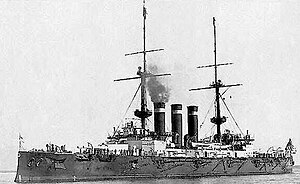Japanese battleship Hatsuse

Hatsuse at anchor
|
|
| History | |
|---|---|
|
|
|
| Name: | Hatsuse |
| Ordered: | 1897 |
| Builder: | Armstrong Whitworth, Elswick |
| Yard number: | 680 |
| Laid down: | 10 January 1898 |
| Launched: | 27 June 1899 |
| Completed: | 18 January 1901 |
| Fate: | Sank 15 May 1904 after striking a mine |
| General characteristics | |
| Class and type: | Shikishima-class pre-dreadnought battleship |
| Displacement: | 14,850 long tons (15,090 t) (normal) |
| Length: | 438 ft (133.5 m) |
| Beam: | 76 ft 9 in (23.4 m) |
| Draught: | 27 ft (8.2 m) |
| Installed power: |
|
| Propulsion: | 2 shafts, 2 vertical triple-expansion steam engines |
| Speed: | 18 knots (33 km/h; 21 mph) |
| Range: | 5,000 nmi (9,300 km; 5,800 mi) at 10 knots (19 km/h; 12 mph) |
| Complement: | 849 (as flagship) |
| Armament: |
|
| Armour: |
|
Hatsuse (初瀬 Hatsuse?) was a Shikishima-class pre-dreadnought battleship built for the Imperial Japanese Navy by the British firm of Armstrong Whitworth in the late 1890s. The ship participated in the early stages of the Russo-Japanese War of 1904–1905, including the Battle of Port Arthur on the second day of the war. She was involved in the subsequent operations until she struck two mines off Port Arthur in May 1904. The second mine detonated one of her magazines and Hatsuse sank almost immediately afterwards with the loss of over half her crew.
Hatsuse was 438 feet (133.5 m) long overall and had a beam of 76 feet 9 inches (23.4 m). She had a full-load draught of 27 feet (8.2 m) and normally displaced 14,850 long tons (15,090 t) and had a crew of 849 officers and enlisted men when serving as a flagship. The ship was powered by two Humphrys Tennant vertical triple-expansion steam engines using steam generated by 25 Belleville boilers. The engines were rated at 14,500 indicated horsepower (10,800 kW), using forced draught, and were designed to reach a top speed of around 18 knots (33 km/h; 21 mph). Hatsuse, however, reached a top speed of 19.11 knots (35.39 km/h; 21.99 mph) from 16,117 indicated horsepower (12,018 kW) on her sea trials. She carried a maximum of 1,643 long tons (1,669 t) of coal which allowed her to steam for 4,000 nautical miles (7,400 km; 4,600 mi) at a speed of 10 knots (19 km/h; 12 mph).
...
Wikipedia
